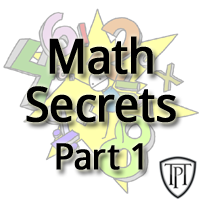
Believe it or not, math would be a lot simpler—and a lot more enjoyable—if your teachers shared some secrets for success. Since we’re so awesome, we thought we would share secrets that will help you breeze through your math homework, quizzes, and tests, with a newfound focus on success!
1. Practice Estimation Techniques & Save Time.
Estimating can save you valuable time on tests, homework, and everyday life. Estimating can even help save you money—ka ching—which is nothing to sneeze at!
| Let’s say you buy 5 King Size candy bars at $1.05 each. The cashier says, “That will be $5.75, please”. Hmmm. You know that $1.05 is close to $1.00, which means that total should be closer to $5 not $6. Your amazing estimation skills just saved you $.50. And those cents add up to dollar over time! |
When you become proficient at estimating, you’ll be able to check your calculations without having to redo them. Estimation mastery saves you valuable seconds of time in a test, but those seconds at up to minutes, minutes for which you can be done with your test and watching everyone else sweating it out.
Estimating helps “drawn to scale” math figures magically turn into a big advantage for you.
Learn to actively observe your everyday surroundings. Whenever possible, try to estimate the things in your environment. For instance, estimate your total when buying groceries. Estimate the change in your pocket just by looking at the coins. Estimate the number of steps in a staircase, then count them on your way up or down and compare your estimate to the actual number. Estimate the number of people in a room. Start grouping things in 2’s, 3’s, 5’s and soon estimation will be easy-breezy and you’ll be on your way to mathematical glory.
2. Use Visual or Pictorial Representations & Solve the Problem Visually.
As mathematics tends to be abstract, it’s in your favor to make it as concrete as possible. You want to be able to wrap your mind around it. A diagram shows data visually, which can simplify complex mathematical data. People process visual information more effectively than obscure symbols and variables.
You know what they say: ”a picture’s worth a thousand math concepts…”
One solution is to draw diagrams to represent information in a way that helps you think distinctly about the problem at hand. You can use Venn diagrams, pie charts or simple tables to show relationships, percentages, and patterns. For geometry questions, draw a figure if one is not provided, and redraw the figure if it is. The more you reinforce concepts using Visual Learning Styles, the more likely you are to learn, and remember, the information. That will help you tremendously on quizzes and tests.
3. Focus on accuracy, and speed will follow.
Once know exactly what you’re doing, you’ll get to the answer faster. Imagine you’re on your way to a location you’ve never been to before. You’ll make a couple of wrong turns, back up a couple of times, and pull a couple of U-turns before you arrive. When you’re going somewhere you’ve been before, you’ll probably just go straight there, using the fastest route.
Don’t get frustrated when your math problems are taking forever. Try to have patience, young grasshoppers, and learn the steps accurately. In a short amount of time, you’ll look back at the struggling version of yourself and wonder why you thought it was so hard!
Practice sets of similar questions at a time to master techniques. Become comfortable with the process of solving the problem instead of focusing on correct answers. By familiarizing yourself with the correct approach, you will automatically start solving problems faster! You need to reach the point where you don’t have to “think” about what the next step is, it just happens.
——————————————————————————
Like these tips? Then you’ll love our other online articles, full of techniques to help you excel at math, other academic subjects, as well as standardized test prep.
